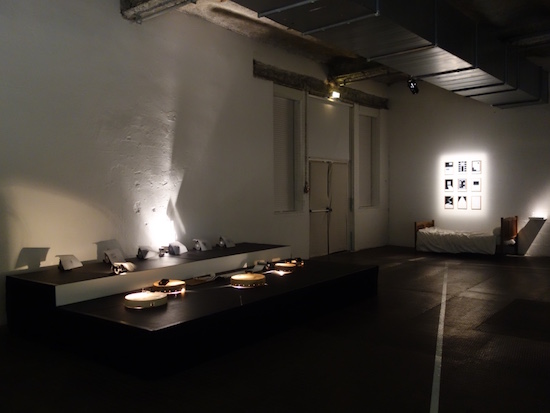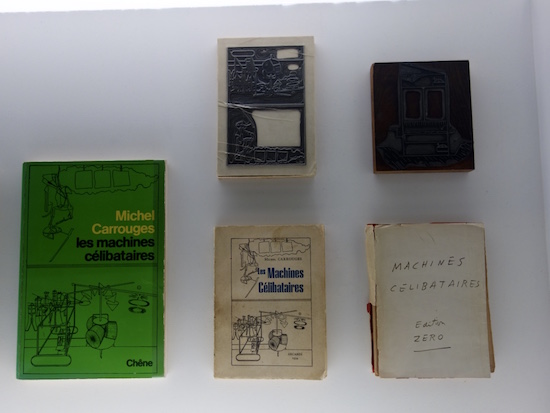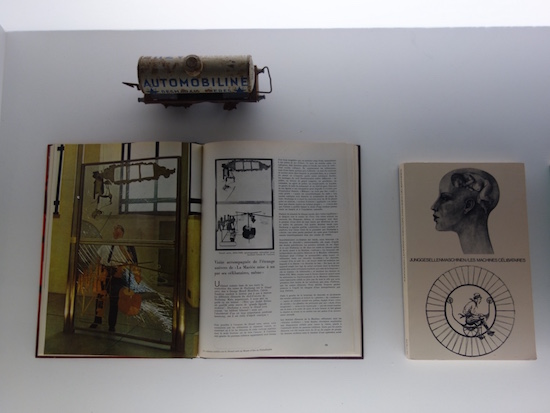Looking over a latticed network of train lines, motorway tunnels and a bustling overpass a statue looms out of the eroded baroque-detailed tower that stands at the corner of Le Lieu Unique. It’s a suitably imposing profile for the space, a renovated former biscuit factory that has functioned as a large multi-purpose arts space for over a decade. In its current incarnation it has been described as a ‘factory for producing the imaginary’. Les Machines Celibataires (Bachelor Machine) – an exhibition which aims to assemble a ‘library in multiple dimensions’ – is a fitting addition to that remit.
Held in a comparatively unassuming upper floor hall, the first work that draws your attention in Les Machines Celibataires is Pierre Bastien’s Paper Orchestra, an installation which combines three previous works (Paper Organs, Paper Drums and Paper Snakes) whilst expanding on these constituents, adding new sections to form an ‘orchestra’. It’s a piece which has toured a host of European festivals and galleries in recent years and one that continues Bastien’s interest in engineering everyday objects for sound.
Set against the wall of one section of the exhibition the installation emits a shifting agitation of fractious rustle which cuts through the silence pervading the hall at the time of my arrival. In the online description that accompanies a video of the piece, an equation has been set out, ostensibly functioning as a compass for the listener:
paper drums + paper organs + paper rain + paper flutes + paper snakes = paper orchestra
Prompting the installation’s dominant commotion are motorized fans affixed to the back of worn-looking drums which, at their centre, are furnished with strips of paper. These conjure the sound of ‘paper drums’ which remain largely active throughout its five-minute performance. Whereas in previous realisations of the installation, where each element has been fixed to the same platform, here, a slightly raised podium has been added. On this upper section lies six cylindrical objects which look like second hand engine parts. In and amongst the agitation of the ‘paper drums’, these cylinder engine parts blow attached pieces of tracing paper into the air enacting a sequence of off-colour notes, thereby identifying themselves as the ‘paper organs’. Longer strands of paper attached to two other parts of mechanical detritus fill either end of the display, intermittently adding lighter moments of paper turbulence (the ‘rain’ and the ‘snakes’) to the orchestra. The culmination of all this comes with a series of eerie faltering noises emanating from the ‘paper flutes’ which sit in the middle of the upper section, like some miniaturised abstract carousel.
Conveying an air of mutant domesticity and meticulous workmanship it loops for the entirety of my time in the hall. A curious contraption, met with ingenuous fascination by groups of huddled children, light hearted bemusement by the parents that accompany them and inquisitive looks by others that mill by. It conjures speculation. In what kind of world could this be used? Despite the strange pattern of sound conveyed in Bastien’s work, scanning the rest of the hall and the objects collected within it begins to reveal what the premise of this installation – and its audible paper processions – might be.

Firstly, it’s worth noting the origin of the term Bachelor Machine, the broader symbolic framework in which the Paper Orchestra is situated. It was first coined by Marcel Duchamp in reference to ideas which were eventually consolidated in his now canonical avant-garde work The Bride Stripped Bare By Her Bachelors, Even (aka ‘The Large Glass’).
The glass in question was divided into upper and lower regions. The lower region is where Duchamp directed the ascription Bachelor Machine, in reference to the Nine Malic Moulds, or The Cemetery of Uniforms & Liveries, strange worn diagrams that are together, reminiscent of a deconstructed treadmill combined with butchered suits of flesh, hung out to dry on the skeleton of an interlinked washing line. These ‘Moulds’ – including characters which vary from a ‘Priest’, a ‘Policeman’, to a ‘Department store delivery boy’ – are, according to Duchamp, held in ‘eros’ matrix’ and are connected to tubes, sieves, a ‘chocolate grinder’ and ‘a chocolate machine’ as well as various other ‘machine’ parts. The upper region, meanwhile, is a region where ‘atmospheric pressure’ and the ‘spark of desire magneto’ are controlled and a ‘love gasoline’ is secreted. Its ‘characters’ include a ‘virgin’ and a ‘bride’, and it’s ‘objects’ feature a ‘Halo of the Bride’ and a ‘Milky Way’.
These designations were compiled by Duchamp in his Green Box – a surreal ‘guide’ of scrawled diagrams and abstruse text packed into one box – extracts from which are displayed just beyond the intermittent din of the Paper Orchestra. Looking over these notes, and the diagram of The Large Glass which sits upon the glass case that contains them, reveals the structural similarity between the two works.
With his orchestra Bastien makes tangible what Duchamp proposed in his ‘delay in glass’. Instead of a frozen moment in perpetuity we witness the workings of the Bachelor Machine in the earthier primitiveness of the ‘paper drums’, whilst later discerning – quite literally – the objects of the machine’s desire in the aerial eeriness of the ‘organ’ and ‘flutes’. In its intent and realisation there’s a childlike wilfulness in bringing a static conceptual fiction to life, imagining it’s ‘Bride’ and its ‘Bachelors’ in sound and motion.
The basis for this connection is further expounded upon elsewhere. In another glass case a few feet away from Duchamp’s Green Box, are editions of Michel Carrouges’ 1954 work The Bachelor Machines. In this work Carrouges highlighted ‘the sexual origin of the Large Glass’ mechanics and their signification of death’ and on the back of this idea drew parallels between Duchamp’s glass and other imaginary machines, as conceived in a select collection of 20th century literature. Most notably he identified Franz Kafka’s short story ‘In The Penal Colony’ and its principal conceit, the "Harrow" machine. With this machine crimes are carved out by needles on the flesh of the accused. The crime is not revealed to the accused until they witness it as a deeply cut legible skin-inscription (supposedly a moment of ecstasy, according to critics) before death inevitably ensues. As always, a wholesome Kafka vision.

In proximity to the display of Carrouges’ work are diagrammatical drawings by his son Jean-Louis Couturier, resembling surreal corruptions of precise school-textbook illustrations – at least, on an initial glance. Greater scrutiny reveals that each of them visualises a work of literature, beginning with Kafka’s ‘In The Penal Colony’ through ‘The Metamorphosis’, Raymound Roussel’s Locus Solus, Jules Verne’s The Carpathian Castle, Lautreamont’s Maldoror, Edgar Allan Poe’s ‘The Pit & The Pendulum’, Alfred Jarry’s The Supermale, and Adolfo Bioy Casares’ The Invention of Morel. They’re each rendered in black lines and sparse white, a specifically oriented series of tableaux which depict dreams and degradation alongside mysterious, variously modified machines, often operating on the basis of industrial belts, cogs and wheels.
Just as Bastien uses objects to make the abstract physically palpable, Couturier’s drawings visualise what was only ever imagined in writing. There’s a similar sense of precision at work too. Bastien’s orchestra repeats the same process and through this repetition evokes a systematic symphony, whilst Couturier’s work is almost surgical in its depictions, as if these were preliminary sketches for the imminent construction of these machines.
It’s the first time Couturier’s drawings have been shown since 1976, when curator Harald Szeemann brought his own show entitled ‘The Bachelor Machines’ to Le Lieu Unique’s native Nantes. This is a precedent which has wielded a significant influence on this contemporary reimagining. In an Art Forum International interview given in 1996, Szeemann revealed the thought process behind his realisation:
"’Bachelor Machines’ was inspired by Duchamp’s Large Glass and similar machines or machinelike men, such as those in Franz Kafka’s short story ‘In the Penal Colony’, Raymond Roussel’s Impressions d’Afrique, and Alfred Jarry’s Supermale le Surmale, and it had to do with a belief in eternal energy flow as a way to avoid death, as an erotics of life: the bachelor as rebel-model, as antiprocreation.”
It would be one of his most celebrated shows. Significantly, Szeemann once said that he wanted to create “not just a group show but a temporary world”, a sentiment which echoes the intent here, of seeing a ‘library in multiple dimensions’. In his show he commissioned full scale replicas of the ‘Harrow’ machine and others referenced in Carrouges’ theory. In a sense the same practice has been repeated here. But instead of a replica, we get a living, breathing sound art riff on the Bachelor Machine – courtesy of Bastien – rather than a mere duplication. In that respect this exhibition surpasses the ambitions of Szeemann, drawing something more immediate and playful out of Carrouges’ ideas.

The connection between the criterion of the Bachelor Machine and the other artefacts lining the walls and filling the space of the exhibition is less clear cut. At one end of the hall a bed lies underneath a lamp-lit display of pared back black-on-white card drawings. Nearby a poster emblazoned with a contemporary block print reads ‘Silent Motors’, the title of a live performance which preceded and inspired Bastien’s Morphine Records release Blue As An Orange. This seems be to the dimension where the curator Marie-Pierre Bonniol brings her own objects into the equation.
When I reached out to Marie after visiting the exhibition, she revealed the underlying premise of this particular segment, likening her perception of what the Bachelor Machine symbolises to a liminal state of consciousness:
"For me, the notion of bachelor machine recovers all the phantasmagorical production which emerges when you’re meeting someone, or something, which links many important symbols you’re the carrier of. A whole world of possibilities, of stories to be written, is getting opened to you, and that’s what I wanted to figure by this imaginary collection of books, just presented by the covers, as a night time library of stories only written in our pre-sleep time."
Contrary to the quasi-mystical idea of Szeemann and his "eternal energy flow", Bonniol attempts to depict the Bachelor Machine in a more relatable light. With the presentation of a more private world – a cross section of a bedroom – there’s a suggestion that the concept of the Bachelor Machine is all-inclusive. Is a bed, as a site for ecstasy and death, where dreams and desires are fathomed, the everyday version of a Bachelor Machine? This is a notion which remains implicit, just as the black and white drawings remain provisional, nebulous narratives.
Altogether this might sound convoluted. There is an extensive chain of peripheral theories surrounding other ideas and other artworks that is essential to understanding and appreciating Les Machines Celibataires. Can a show that relies on so many precedents really resonate? Despite the slightly convoluted scaffolding underpinning the whole thing, it’s more ingratiating than confounding, inviting those who enter its exhaustively allusive world to conjure suppositions on how these works are connected, even without the 101 in art history and the recitation of theory.
From walking around the exhibition and witnessing the arrangements of book covers, Duchamp’s cryptic scrawls, Bastien’s Paper Orchestra, Couturier’s drawings and Bonniol’s vision of a private space, it’s abundantly clear that this has more of a compelling, variegated edge than many exhibitions which are predicated on a similar extent of archive material. There’s always a danger of making such a show a purely retrospective affair. Here it feels as though there’s a reflection on what the Bachelor Machine means in the present. Bastien’s work is key to that, enlivening the space with a new, living slant on Duchamp’s static conception and revelling in the same playful absurdity.
When art, sound, literature, theory and their curation are interlaced in such a way, you begin to wonder how many other untold connections could be speculated upon, what other artworks across the breadth of these disciplines could hide a thematic thread, a covert cause for profound interrogation. Besides the potentiality of this peripheral exploration, Les Machines Celibataires distils the abstract and imaginary into an intricate constellation which draws these visions nearer to the real and tangible. Like an esoteric library wing hidden in an alternative school of knowledge, in one space it materialises manifold fantasies.


